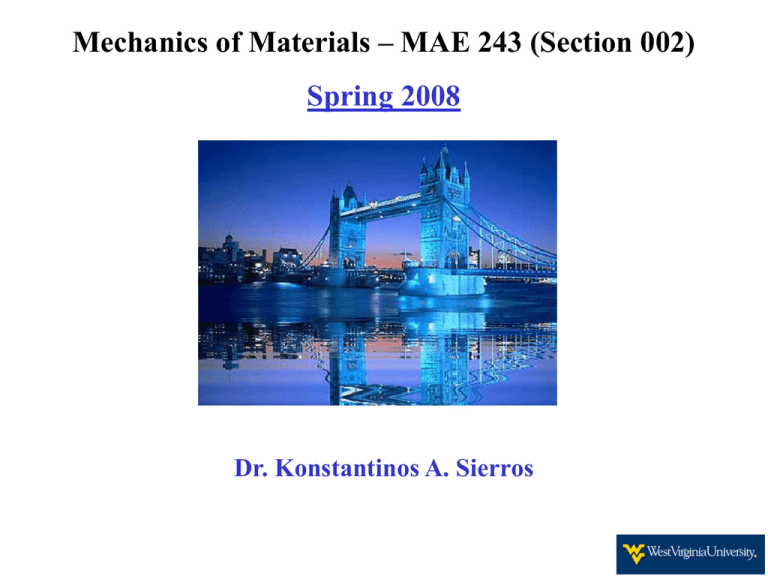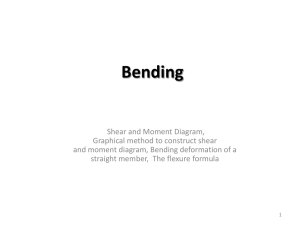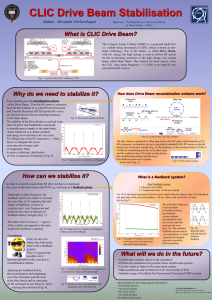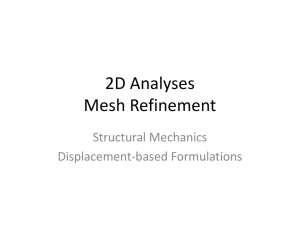Lecture 15
advertisement

Mechanics of Materials – MAE 243 (Section 002) Spring 2008 Dr. Konstantinos A. Sierros 3.5: Stresses on inclined planes Graph of normal stresses and shear stresses versus angle of the inclined plane FIG. 3-22 Copyright 2005 by Nelson, a division of Thomson Canada Limited Stress elements oriented at = 0 and = 45° for pure shear FIG. 3-23 Copyright 2005 by Nelson, a division of Thomson Canada Limited • The normal stresses acting on the 45o element correspond to an element subjected to shear stresses τ acting in the directions shown in fig. 3-23a 3.5: Strains in pure shear Torsion failure of a brittle material by tension cracking along a 45° helical surface FIG. 3-24 Strains in pure shear: (a) shear distortion of an element oriented at = 0, and (b) distortion of an element oriented at = 45° FIG. 3-25 Copyright 2005 by Nelson, a division of Thomson Canada Limited Copyright 2005 by Nelson, a division of Thomson Canada Limited • Shear distortion (fig. 3-25a) and γ = τ/G • When θ = 45o (fig. 3-25b) and εmax = γ/2 • The existence of maximum tensile stresses on planes at 45o to the x-axis explains why bars of brittle materials that are under torsion fail by cracking along a 45o helical surface (fig. 3-24) 3.6: Relationship between moduli of elasticity E and G • It can be shown that shear modulus of elasticity G and Young’s modulus E are related by: • We see that E, G and v are not independent properties of a linearly elastic material. Instead if two of them are known the third can be calculated • Typical values of E,G and v are listed in Table H-2, Appendix H 3.7: Transmission of power by circular shafts • The work W done by a torque of constant magnitude is equal to the product of the torque and the angle ψ through which it rotates •Power is the rate at which work is done Power is expressed in watts (W). 1W = Nm/s Shaft transmitting a constant torque T at an angular speed FIG. 3-29 Copyright 2005 by Nelson, a division of Thomson Canada Limited 3.9: Strain energy in torsion and pure shear • Bar AB is in pure torsion under the action of the torque T. The free end rotates through an angle φ. The strain energy U of the bar is • Using the equation φ = TL/GIp we can express the strain energy as follows FIG. 3-34 Torque-rotation diagram for a bar in torsion (linearly elastic material) Prismatic bar in pure torsion FIG. 3-35 Copyright 2005 by Nelson, a division of Thomson Canada Limited Copyright 2005 by Nelson, a division of Thomson Canada Limited 3.9: Strain energy density in pure shear • The SI units for strain energy is joule per cubic meter and the USCS unit is inch-pound per cubic inch FIG. 3-36 Element in pure shear Copyright 2005 by Nelson, a division of Thomson Canada Limited 4.1: Shear forces and bending moments • In this chapter we will study beams which are structural members subjected to lateral loads. • Lateral loads are forces or moments that act perpendicular to the axis of the bar • The beams shown in figure below are classified as planar structures because they lie in a single plane. If all loads act in that same plane and deflections occur in that plane, then we refer to that plane as the plane of bending Examples of beams subjected to lateral loads FIG. 4-1 Copyright 2005 by Nelson, a division of Thomson Canada Limited 4.2: Types of beams • Simply supported beam (fig 4-2a). A pin support prevents translation at the end of the beam but does not prevent rotation. The roller support at end B cannot prevent translation in the horizontal direction but can prevent translation in the vertical direction • A cantilever beam (fig 4-2b) is fixed at one end and free at the other. At the fixed support the beam can neither translate nor rotate, whereas at the free end it may do both. Therefore, force and moment reactions may exist at the fixed support FIG. 4-2 Types of beams: (a) simple beam, (b) cantilever beam, and (c) beam with an overhang Copyright 2005 by Nelson, a division of Thomson Canada Limited • A beam with an overhang (fig 4-2c) is a beam which is simply supported at points A and B and projects beyond point B. The segment BC is similar to a cantilever beam but also the beam axis may rotate at point B 4.2: Types of loads • Concentrated loads (eg. P1, P2, P3, P4 ) • When a load is spread along the axis of a beam is a distributed load. Distributed loads are measured by their intensity q (force per unit distance) •Uniformly distributed load has constant intensity q (fig 4-2a) • A varying load has an intensity q that changes with distance along the axis. Linearly varying load from q1 - q2 (fig 4-2b) • Another kind of load is a couple of moment M1 acting on the overhanging beam (fig 4-2c) FIG. 4-2 Types of beams: (a) simple beam, (b) cantilever beam, and (c) beam with an overhang Copyright 2005 by Nelson, a division of Thomson Canada Limited 4.2: Reactions • Finding the reactions is the first step in the analysis of a beam. • If the problem is statically determinate the reactions can be found from free body diagrams and equations of equilibrium. • For example consider a simply supported beam (figure below) 4.3: Shear forces and bending moments • When a beam is loaded by forces or couples, stresses and strains are created throughout the interior of the beam. To determine these stresses and strains we must first find the internal forces and couples that act on cross-sections of beams • Shear force V and bending moment M. Action of the left-hand part of the beam on the right-hand part (fig 4-4b). FIG. 4-4 Shear force V and bending moment M in a beam Copyright 2005 by Nelson, a division of Thomson Canada Limited 4.3: Sign convections • A positive shear force acts clockwise against the material. A positive positive bending moment compresses the upper part of the beam • A positive shear force tends to deform the element by causing the right-hand face to move downward. A positive moment compresses the upper part of the beam Sign conventions for shear force V and bending moment M FIG. 4-5 Deformations (highly exaggerated) of a beam element caused by (a) shear forces, and (b) bending moments FIG. 4-6 Copyright 2005 by Nelson, a division of Thomson Canada Limited Copyright 2005 by Nelson, a division of Thomson Canada Limited






